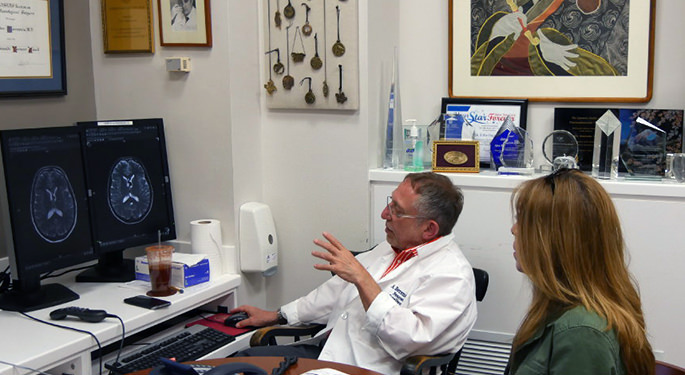
Stroke
Your brain requires a constant flow of blood, to maintain the oxygen and nutrients necessary to keep everything functioning properly. A stroke happens when your brain abruptly stops receiving blood and can happen with little or no warning. Once your brain is deprived of blood, brain cells become damaged or die within a few minutes, which can cause physical, cognitive, and mental disabilities. Brain cells rarely if ever regenerate.
Sometimes a stroke is ‘silent,’ which means you do not have or do not remember any symptoms. Silent strokes can cause permanent damage. If you have more than one silent stroke, it can lead to problems with thinking and memory.
There are two types of stroke: ischemic stroke, atherosclerosis and ischemic stroke caused by a blood clot in an artery that supplies blood to the brain; and hemorrhagic stroke, which happens when a weak blood vessel bursts causing blood to collect and build pressure in the brain.
Signs of a stroke appear suddenly and can include:
- Numbness or weakness, often on one side of the body
- Vision changes in one or both eyes
- Difficulty swallowing
- Severe headache for no obvious reason
- Dizziness or difficulty with walking or balance
- Confusion or difficulty speaking or understanding others
Risk Factors
Strokes are more common in older adults, but can occur at any age. More men than women have strokes each year, but women are more likely to die of stroke. African Americans are more than twice as likely as Caucasians to have a stroke and Latinos also have an elevated risk.
Additional factors that can increase your chances of having a stroke are:
- Smoking, including second-hand smoke (risk can increase more with use of certain forms of oral contraceptives)
- High blood pressure, typically 140/90 mm Hg or higher
- Carotid or other artery disease
- Personal history of stroke, heart attack, or transient ischemic attack
- Family history of stroke
- Diabetes
- High blood cholesterol (240+ mg/dL total cholesterol, 100+ mg/dL LDL (bad) cholesterol, or less than 40 mg/dL of HDL (good) cholesterol)
- Physical inactivity and obesity
- Hormone replacement therapy
Heart Healthy Habits
There are a few ways to lower your risk of stroke and heart disease:
- Monitor and control your blood pressure.
- Keep a close eye on your cholesterol.
- Watch your blood sugar.
- Quit smoking.
- Eat a healthy diet with plenty of fresh fruit, vegetables, and whole grains. Watch your intake of fat, salt, and sugar.
- Exercise regularly.
- Maintain a healthy weight
Vagus Nerve Stimulation for Stroke Rehabilitation
After experiencing a stroke, many survivors continue to suffer from persistent impaired upper limb function and weakness. Vagus Nerve Stimulation (VNS) electrical pulses release neuromodulators in the brain that create or strengthen neural connections to enhance the relevance of physical therapy and improve upper limb function. “Pairing VNS with rehabilitation helps stroke survivors regain their independence and improve their quality of life, months or even years after suffering from a stroke,” says cerebrovascular neurosurgeon Christopher Kellner, MD Co-Founder of the Enhanced Stroke Recovery Program. More information about paired vagus nerve stimulation for stroke rehabilitation.